loading...
- No. 9, Xingyuan South Street, Dongwaihuan Road, Zaoqiang County, Hengshui, Hebei, China
- admin@zjcomposites.com
- +86 15097380338
- Welcome to visit our website!
frp material water tank
The Advantages of FRP Material in Water Tank Construction
In recent years, the demand for effective and durable water storage solutions has grown significantly. As industries and residential areas expand, the need for efficient water management systems becomes increasingly crucial. One of the most innovative solutions for water storage is the use of Fiber Reinforced Polymer (FRP) materials. These materials offer numerous advantages over traditional water tank construction methods, making them a preferred choice for many applications.
What is FRP?
Fiber Reinforced Polymer (FRP) is a composite material made from a polymer matrix reinforced with fibers. The fibers, often made of glass, carbon, or aramid, significantly enhance the material's strength and durability. The polymer, usually a thermosetting resin, provides resistance to environmental factors such as corrosion and chemical attacks. This combination results in a lightweight yet strong material ideal for various structural applications, including water tanks.
Advantages of FRP Water Tanks
1. Corrosion Resistance One of the primary benefits of FRP water tanks is their resistance to corrosion. Unlike traditional materials such as steel or concrete, which can deteriorate over time due to exposure to water, chemicals, and environmental conditions, FRP does not rust or corrode. This makes FRP tanks particularly suitable for storing potable water, industrial chemicals, or wastewater, ensuring the integrity and safety of the stored liquids.
2. Lightweight and Easy to Install FRP tanks are significantly lighter than their steel or concrete counterparts. This lightweight nature simplifies transportation and installation, reducing costs associated with heavy lifting equipment and labor. The ease of installation also allows for quicker setup times, enabling facilities to become operational faster.
3. Durability and Longevity When properly manufactured and installed, FRP water tanks can last for decades. Their resilience to environmental stressors means they require less maintenance and can operate efficiently over a long lifespan. This longevity translates into lower replacement costs for facility managers and homeowners alike.
frp material water tank

4. Customization Options FRP materials offer a high degree of flexibility in design. Manufacturers can tailor the size, shape, and configuration of water tanks to meet specific site requirements and capacity needs. This customization capability is particularly beneficial for industries requiring tanks with unique dimensions or features, such as curved surfaces or integrated filtration systems.
5. Thermal Insulation FRP tanks possess natural thermal insulating properties. This means they can help maintain the temperature of the water stored within, minimizing heat exchange with the external environment. Such insulation is particularly beneficial for applications reliant on maintaining water temperature for quality or energy efficiency purposes.
6. Eco-Friendly Many FRP products are designed and manufactured with sustainability in mind. The production of FRP materials often generates less waste and uses less energy compared to traditional materials. Additionally, as FRP tanks have a longer lifespan and lower maintenance needs, they contribute to reducing the environmental impact associated with frequent replacements and repairs.
7. Resistance to UV Radiation UV radiation can degrade many materials over time. However, FRP is designed to withstand UV exposure, minimizing the risk of deterioration from sunlight. This characteristic makes FRP tanks ideal for outdoor installations, where they remain exposed to various weather conditions.
8. Cost-Effectiveness While the initial investment for FRP tanks might be higher than traditional materials, the long-term savings through reduced maintenance, durability, and energy efficiency make FRP a cost-effective solution. The reduced need for replacements and repairs further enhances their financial appeal.
Conclusion
In conclusion, FRP materials represent a significant advancement in water tank technology. With their unique combination of strength, durability, corrosion resistance, and customizability, FRP tanks offer remarkable advantages for both industrial and residential applications. As the world continues to seek innovative solutions for sustainable water management, embracing materials like FRP can lead to safer, more efficient, and more environmentally friendly practices in water storage and distribution. Ultimately, the adoption of FRP water tanks not only benefits individual users but also contributes to broader efforts in promoting sustainability and resilience in water infrastructure.
-
GRP Structures: The Future of Lightweight, High-Performance EngineeringNewsJun.20,2025
-
FRP Water Tank: High-Performance Storage for Corrosive and Clean Water SystemsNewsJun.20,2025
-
FRP Square Tube: The New Industry Standard for Chemical and Structural ApplicationsNewsJun.20,2025
-
FRP Pultruded Profiles: The Ultimate Choice for Lightweight Structural StrengthNewsJun.20,2025
-
FRP Handrails: The Safer, Smarter, and Stronger Choice for Modern InfrastructureNewsJun.20,2025
-
FRP Grating: The Smart Solution for Durable, Lightweight Industrial FlooringNewsJun.20,2025
-
Why Choose a Galvanized Water Tank for Your Storage NeedsNewsMay.21,2025
